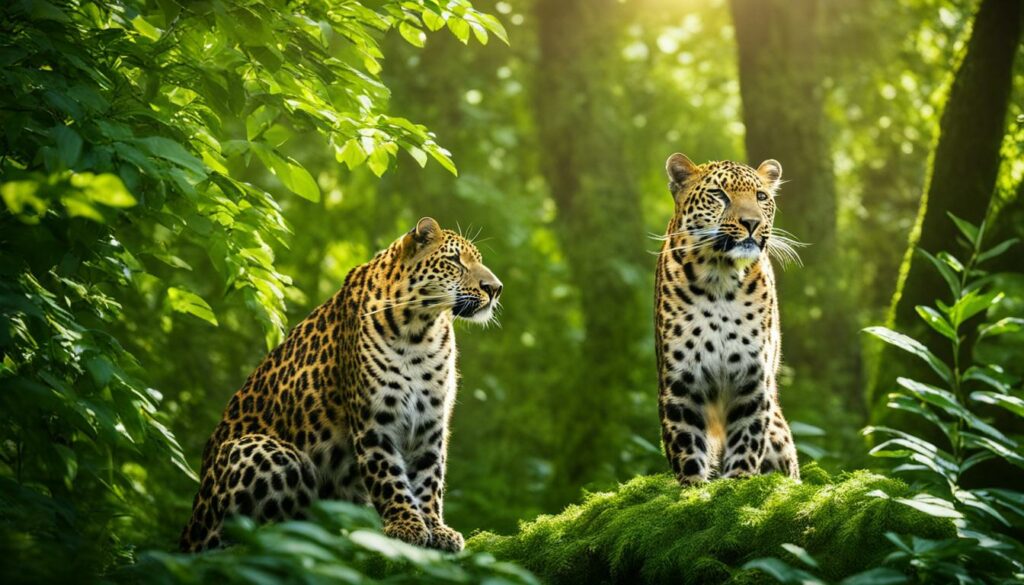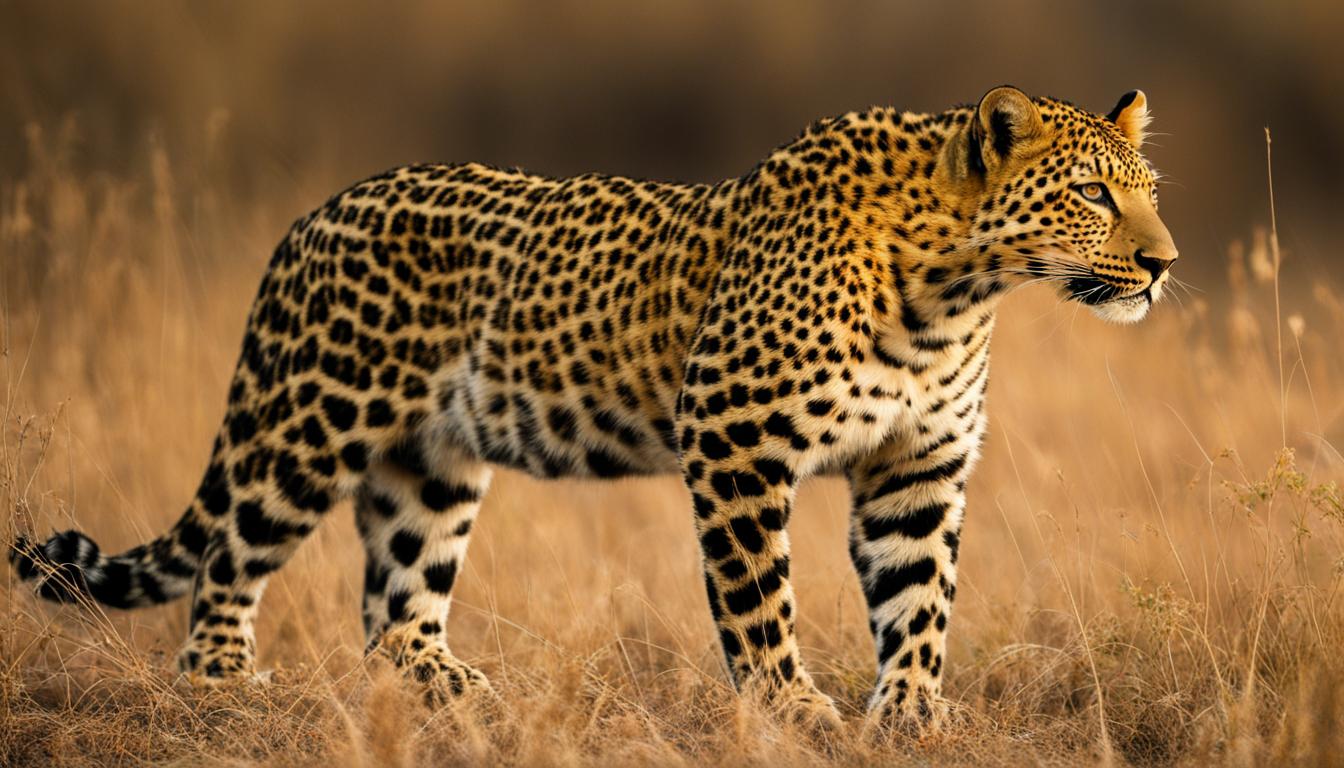Welcome to our blog post on the population of leopards in the wild. In this article, we will explore the current leopard population size, trends, and the challenges they face. Let’s dive in and learn more about these magnificent creatures.
The Impact of Poaching and Habitat Loss on Leopard Population
The Amur leopard population faces significant challenges due to poaching and habitat loss, which have led to a decline in their numbers. Poaching for their highly sought-after fur and bones, driven by illegal wildlife trade, poses a serious threat to the survival of these magnificent big cats. Their habitat is also under threat from various factors, including forest fires, logging activities, and land conversion for agriculture.
As the demand for leopard fur and bones continues, poaching remains a persistent issue. The illegal wildlife trade, driven by the belief in the medicinal properties of leopard bones, fuels the relentless pursuit of Amur leopards. This unsustainable demand has contributed to the decline in their population over the years.
Habitat loss is another major factor that affects leopard populations. Forest fires, often exacerbated by human activities, have destroyed large portions of their natural habitat. Additionally, logging operations and the conversion of land for agriculture further encroach upon their territory, limiting their available space and resources.
The Impact of Poaching and Habitat Loss on Leopard Population
“The illegal wildlife trade and habitat loss are gravely endangering the Amur leopard population, pushing them closer to extinction. Urgent action is needed to address these threats and ensure the long-term survival of this magnificent species.”
Table: Key Threats to Amur Leopard Population
| Threat | Description |
|---|---|
| Poaching | Driven by demand for fur and bones in the illegal wildlife trade |
| Habitat Loss | Caused by forest fires, logging, and land conversion for agriculture |
The combined impact of poaching and habitat loss on the Amur leopard population requires urgent conservation efforts. Without appropriate measures to address these threats, the decline in their numbers may continue, pushing them closer to the brink of extinction. Conservation organizations, governments, and local communities must work together to combat poaching, strengthen protections for their habitat, and promote sustainable land-use practices to ensure the survival of Amur leopards for future generations.
Conservation Efforts and Increase in Population
Conservation efforts by organizations like the World Wildlife Fund have played a crucial role in reversing the decline of the Amur leopard population. One significant achievement is the establishment of the Land of the Leopard National Park in 2012. This protected area covers a substantial portion of the leopards’ breeding grounds and habitat, providing them with a safe haven to thrive.

Anti-poaching teams have been deployed in the region to monitor and protect the leopards from illegal hunting. Camera traps strategically placed throughout the park have also been instrumental in monitoring the leopard population. By tracking their movements and collecting valuable data, researchers can gain insights into their behavior, population size, and distribution.
The efforts put into conserving the Amur leopards have yielded positive results. Over the past decade, the population has increased from an estimated 30 individuals to around 100 individuals in the wild. This remarkable growth showcases the effectiveness of targeted conservation initiatives.
The Importance of Monitoring and Research
Continued monitoring and research are vital to ensure the ongoing success of conservation efforts. Understanding the leopard population dynamics, their genetic diversity, and their interactions with the environment is essential for informed decision-making.
| Research Areas | Key Findings |
|---|---|
| Population Size and Distribution | The population of Amur leopards in the wild is currently estimated to be around 100 individuals, with the majority inhabiting the south-west Primorye region in Far East Russia. |
| Habitat Connectivity | Research has identified crucial corridors and habitat patches that need to be protected and restored to ensure effective movement and gene flow within the leopard population. |
| Gender Ratio | Studies have revealed that the gender ratio among the Amur leopards is relatively balanced, which is crucial for maintaining a healthy breeding population. |
Future Conservation Efforts
Despite the increase in population, Amur leopards still face significant challenges. To ensure their long-term survival, it is crucial to focus on habitat protection and restoration, strengthening anti-poaching measures, and involving local communities in conservation initiatives. The establishment of a transboundary nature reserve between Russia and China would further enhance the conservation efforts and protect the leopards’ range.
- Continue monitoring the population size, behavior, and health of the Amur leopards.
- Implement habitat restoration programs to improve connectivity and provide additional resources for the leopards.
- Enhance international collaboration and cooperation to protect the leopards’ habitat across borders.
- Engage local communities in conservation efforts through education, awareness, and sustainable development initiatives.
The future of Amur leopards depends on our collective commitment to their conservation. By working together, we can secure a brighter future for these magnificent big cats and preserve the unique biodiversity of their habitat.
The Vulnerability of Amur Leopard Numbers
While there has been a slight increase in the population of Amur leopards in recent years, their numbers still remain critically low, making them vulnerable to various threats. With a concentrated population primarily inhabiting the south-west Primorye region in Far East Russia, these leopards face the risk of catastrophic events that could decimate their population. Continued efforts in leopard population survey and research are crucial to monitor and address these vulnerabilities.
The small population size of Amur leopards leaves them susceptible to potential disease outbreaks and forest fires. A single outbreak of a contagious disease could rapidly spread and impact a significant portion of the population, leading to a severe decline. Similarly, forest fires, fueled by climate change and human activities, pose a significant threat to the limited habitat of these leopards. A single fire could destroy vast areas of their territory, leaving them with limited resources and increased competition for survival.
To mitigate these vulnerabilities, ongoing leopard population research is essential. By studying their behavior, habitat preferences, and potential threats, researchers can identify strategies to protect and conserve the Amur leopard population. Through comprehensive surveys and monitoring programs, scientists can gather valuable data on the leopards’ population dynamics, assess their health and genetic diversity, and implement targeted conservation measures to ensure their long-term survival.
The Importance of Research
Research plays a pivotal role in understanding the vulnerabilities of the Amur leopard population and guiding conservation efforts. In addition to population surveys, research efforts focus on mapping leopard habitat, identifying key corridors for migration and dispersal, and studying the impacts of human activities on their survival. By combining scientific knowledge with local expertise, researchers can develop evidence-based conservation strategies that address the specific needs and challenges faced by Amur leopards.
| Research Objectives | Methods | Expected Outcomes |
|---|---|---|
| Population Dynamics | Camera traps, genetic analysis | Insights into population growth, stability, and genetic diversity |
| Habitat Assessment | Satellite imagery, field surveys | Identification of critical habitat, assessment of habitat quality |
| Human-Wildlife Conflict | Interviews, surveys | Understanding the impacts of human activities on leopard behavior and survival |
The valuable findings from research can inform the development and implementation of conservation strategies that address the specific vulnerabilities of Amur leopards. By combining research with community engagement and international collaboration, we can work towards protecting and securing the future of these beautiful and endangered big cats.
The Importance of Amur Leopards and Future Conservation Efforts
The Amur leopards, with their striking beauty and powerful presence, play a vital role in maintaining the delicate balance of their ecosystem. As top predators, they help regulate the populations of their prey species, ensuring a healthy abundance of herbivores and maintaining the overall health of the forest. Their conservation is not only crucial for their own survival but also for the well-being of other species that depend on the same habitat.
Efforts to protect the Amur leopards have shown promise in recent years. The establishment of the Land of the Leopard National Park in 2012 has provided a safe haven for these magnificent creatures. Covering a significant portion of their breeding grounds and habitat, the park has become a stronghold for the survival and growth of the Amur leopard population. This, coupled with anti-poaching measures and the use of camera traps for monitoring, has contributed to the increase in their numbers.
| Conservation Achievements | Impact on Leopard Population |
|---|---|
| Establishment of Land of the Leopard National Park | Provided a safe habitat and breeding grounds |
| Anti-poaching measures | Reduced illegal hunting and trade of leopard parts |
| Camera trap monitoring | Improved understanding of leopard population dynamics |
However, despite the progress made, Amur leopards remain vulnerable. With a small population concentrated in a limited geographic area, they are susceptible to catastrophic events such as disease outbreaks or forest fires. Continued conservation efforts are essential to address these challenges and ensure the long-term survival of this endangered species.
Transboundary Conservation
In an effort to expand conservation efforts, plans are underway to establish a transboundary nature reserve between Russia and China. This reserve would further protect the Amur leopard’s range and promote collaboration between both countries in preserving this iconic species. It is a crucial step towards securing a future for the Amur leopards and ensuring the survival of their unique genetic lineage.
“The Amur leopard is a symbol of our shared responsibility to protect and preserve our planet’s biodiversity. By working together, we can make a difference and secure a brighter future for these magnificent creatures.” – Conservationist Jane Goodall
Raising awareness about the importance of Amur leopards and involving local communities in conservation efforts are also key components of future conservation endeavors. By educating people about the value of these elusive cats and their role in maintaining a healthy ecosystem, we can foster greater understanding and support for their protection.
The journey to safeguard the Amur leopard population is an ongoing one, with many challenges along the way. However, with continued dedication and collaborative efforts, we can ensure a future where these majestic predators thrive in their natural habitat.

Conclusion
The population of Amur leopards remains critically endangered, with an estimated 100 individuals left in the wild. Despite the challenges they face, conservation efforts have led to a slight increase in their numbers.
Continued conservation actions, such as anti-poaching measures, habitat protection, and community involvement, are crucial to ensure the long-term survival and recovery of this rare and beautiful species.
It is essential to maintain a focus on leopard population conservation and address the factors that contribute to their decline. By implementing robust anti-poaching controls, establishing protected areas, and involving local communities, we can make a significant impact on the future of Amur leopards.
Protecting the leopard population size is not only important for their species but also for the overall health of the ecosystem. Let us join hands in raising awareness, supporting conservation organizations, and advocating for the preservation of the Amur leopard population for generations to come.
What is the current status of leopard populations in the wild?
The current status of leopard populations in the wild is concerning, with habitat loss and poaching threatening their survival. However, there are encouraging leopard conservation success stories, such as the establishment of protected areas and the implementation of anti-poaching measures in certain regions. These efforts are crucial for the long-term sustainability of leopard populations.
FAQ
How many Amur leopards are left in the wild?
The population of Amur leopards is estimated to be around 100 individuals in the wild.
What are the major threats to the Amur leopard population?
The major threats to the Amur leopard population are poaching for fur and bones, as well as habitat loss.
Are Amur leopards increasing in numbers?
Yes, there has been a slight increase in the Amur leopard population over the past decade due to conservation efforts.
How is the Amur leopard population monitored?
Anti-poaching teams and camera traps are used to monitor the Amur leopard population.
Why are Amur leopards vulnerable to catastrophic events?
With a small population concentrated in one region, Amur leopards are at risk of catastrophic events like disease outbreaks or forest fires.
What is the importance of Amur leopards in their ecosystem?
Amur leopards play a crucial role as top predators, maintaining a healthy balance of species and contributing to the overall health of the forest.
What can be done to ensure the long-term survival of Amur leopards?
Ongoing anti-poaching controls, the establishment of protected areas, and the cooperation of local communities are essential in ensuring the long-term survival and growth of the Amur leopard population.
How many Amur leopards are estimated to be left in the wild?
The population of Amur leopards is estimated to be around 100 individuals in the wild.
What are the major threats to the Amur leopard population?
The major threats to the Amur leopard population are poaching for fur and bones, as well as habitat loss.
Are Amur leopards increasing in numbers?
Yes, there has been a slight increase in the Amur leopard population over the past decade due to conservation efforts.
How is the Amur leopard population monitored?
Anti-poaching teams and camera traps are used to monitor the Amur leopard population.
Why are Amur leopards vulnerable to catastrophic events?
With a small population concentrated in one region, Amur leopards are at risk of catastrophic events like disease outbreaks or forest fires.
What is the importance of Amur leopards in their ecosystem?
Amur leopards play a crucial role as top predators, maintaining a healthy balance of species and contributing to the overall health of the forest.
What can be done to ensure the long-term survival of Amur leopards?
Ongoing anti-poaching controls, the establishment of protected areas, and the cooperation of local communities are essential in ensuring the long-term survival and growth of the Amur leopard population.











